Late August Farm Update
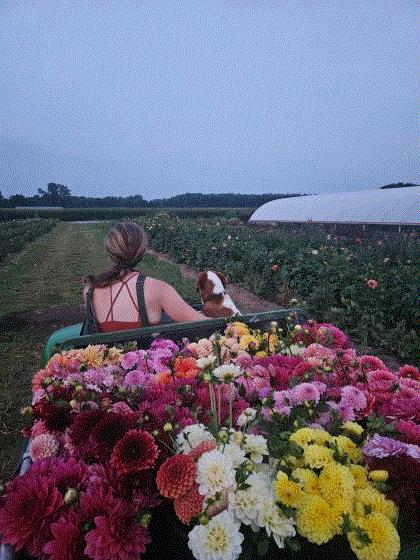
Tater and I on the gator with a fresh load of dahlias
Alright folks, we are heading into the final stretch! As I we get ready to flip the calendar to September, I feel like we are getting to the last leg of peak season. The hope of cooler temperatures and reduced pest pressure keeps me going. Once I flip the calendar to next month I feel a huge wave of relief. Don’t get me wrong, we are still harvesting a ton of flowers; the fields are brimming with dahlias, sunflowers, celosia, zinnias and a couple other fun surprises until October. But, the daily farm flow in September shifts from planting like crazy to strategizing field clean up and gearing up for Christmas flowers. Yes, Christmas—you read that correctly. We started some end-of-year anemone, ranunculus, snapdragons and stock last month and we will continue to sow more in the coming weeks.
This week, the highs are in the 90s again and I am protecting our sweet little anemone and ranunculus corms with extra shade, love and undivided attention. We need this crop more than ever this season since we hired more people. More labor means we need more revenue and a longer season. I’ll let you all know how this science experiment goes.
Meanwhile, we are also thinking about field cleanup. I look forward to dispatching some of our tired summer annuals this week and pulling up the plastic.
Tater is also staying busy. She’s chasing the late summer crop of young rabbits—an unintentional side effect of a mild winter. Needless to say she has her work cut out for her.
In this edition of Bloom Beat we are talking about campanula scheduling, Sun Valley closing, Great Lakes Gladiolas, and more! With all that being said, let’s talk shop.

Campanula Succession Planting

Batch 1 from our campanula plug trial.
Our friends at Sakata sent Tater and me some campanula plug trays to try our hand at growing campanula plugs that underwent lighting treatments while in the plug trays. You can check out our previous edition of
Bloom Beat talking about
Campanula succession planting. Our florists love campanula; locally grown campanula are a lot fuller and higher quality than the ones from the wholesaler.
Each season, Tater and I sow campanula in February. My favorite series is
Champion II from Sakata. They are known for their uniformity and upward-facing blooms. According to our friends at Sakata, this is the natural season schedule for campanula without the need for photoperiod manipulation in the northern hemisphere. In southeast Michigan they flower from the end of May into early June. They are a crop for after Mother’s Day. If you attempt to start campanula later in the season without manipulating the photoperiod you get short squatty, unsaleable stems.
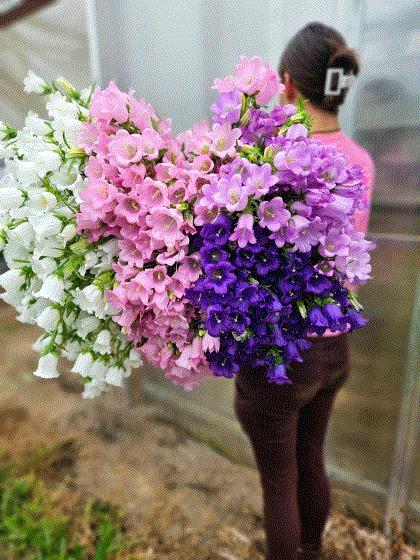 Batch 2 of our campanula plug trial.
Batch 2 of our campanula plug trial.
Our friends at Sakata sent us two plug shipments:
-Batch 1: 200-cell plug trays sown in week 8 and shipped in week 14. These were grown under ambient light, and received natural short days.
-Batch 2: 128-cell plugs were sown week 15 and shipped week 23. Plugs were grown under short days with artificial lighting (less than 12 hours).
Batch 1 flowered for us in the middle of June. There was some overlap with the plug trays we started ourselves two weeks earlier, which was to be expected. Stems were well over 3 ft. tall and very strong.
Regarding batch 2, the folks at Sakata recommended a larger plug size for campanula transplants under long-day conditions so that they have enough time to develop more leaves before planting in the greenhouse under long-day conditions. Bigger plants at transplanting means bigger flowers. We did not give the second batch any special treatment compared to the first batch once we received the plugs. We planted the plugs as soon as we received them into mineral soil in one of our 40% shade greenhouses. Batch 2 started flowering week 31. The stems were a touch shorted and thinner than the first succession but still saleable and beautiful. Our customer loved them.
Would you be interested if suppliers offered pre-lit campanula plugs for later in the season? Our friends at Sakata would like to know! Drop Tater and me a line at
ldaschner@ballpublishing.com. For more info about Campanula production, check out the culture sheet
HERE.

Sun Valley Closing
Below is an excerpt from a previous edition of Bossman Beytes’ newsletter, Acres Online. For those of you new to the industry, Sun Valley was one of the largest cut flower farms in the United States. But sadly, the industry giant closed its doors. Read the full story below, and take note as to not make the same mistakes.
I never like to hear about a long-standing, successful business suddenly shutting down. But when it happens, I do like to know why, and share the details, in hopes that others can learn from the situation.
California-based cut flower grower Sun Valley Floral Farms recently shook up the cut flower world with the news of its pending closing. We knew something drastic was happening back in May, when news came out that Sun Valley had issued layoff notices to their Arcata and Oxnard workforces under the federal WARN (worker adjustment and retraining notification) Act.
Now CEO and President Lane DeVries, who has been with the company since 1984, has written a letter to customers and the industry in general citing the causes of the tough decision he and the company leaders had to make.
After its start in 1948, Sun Valley grew rapidly, expanding to three locations—Arcata, Willow Creek and Oxnard, California—and more than 400 employees to keep up with the demand for their flowers, especially bulb crops like year-round tulips (made possible thanks to a partnership with a New Zealand grower).
However, setbacks began piling up with the Great Recession. Cited Lane:
- “In 2008, we lost 75% of our workforce in Arcata due to an immigration action by the government. The ensuing domino effect on operations lasted for nearly 18 months and left the company with a huge financial hole, and lasting scars.
- “In 2019, FTD/Proflowers, one of Sun Valley’s largest customers at the time, filed for bankruptcy right after Mother’s Day and several million dollars never were paid.”
- “The pandemic in the Spring of 2020 left us with millions of flowers blooming in the greenhouses.”
- “At the same time, business conditions in California have made operating a greenhouse flower company very challenging. The rising cost due to a series of rapid minimum wages increases, and the phased-out elimination of the agricultural overtime exemption has seriously raised the company’s unit cost in recent years.”
- “Insurance expenses have quadrupled in the last five years. Natural gas costs have gone up dramatically and electricity expenses have nearly tripled in the last 10 years.”
Lane concluded, “These cumulative factors had a dramatic impact on our competitive position in the marketplace. In many cases our customers were unwilling to accept price increases needed to offset the cost increases.
“These conditions have put the company deeper into debt, and with the current interest rates, it has deteriorated the financial state of the company.
“As owners, we reached the point of having difficulty seeing a viable way out on our own accord.
“In the last 12 months the company has searched for a suitable investor or a buyer for the entire business. While there were some leads, no buyer for the entire company materialized.“This left us at the point of closing the doors …”
Lastly, in a small bright spot, they managed to transfer the leases on their Willow Creek farm to Continental Floral Greens where they produce ilex, rosehips, cotinus, snowberries and viburnum. And Continental will be growing some core Sun Valley flowering crops, such as Butterfly ranunculus and possibly iris.
As for Lane, he says he will take on an advisory/consulting role with Continental. Sun Valley’s story is not dissimilar to that of another West Coast nursery, Skagit Garden, which closed earlier this spring. They cited “current economic issues including market pressures, production cost, energy cost, freight cost and the business climate in the State of Washington” as all contributing to the decision.

A Visit to Great Lakes Glads
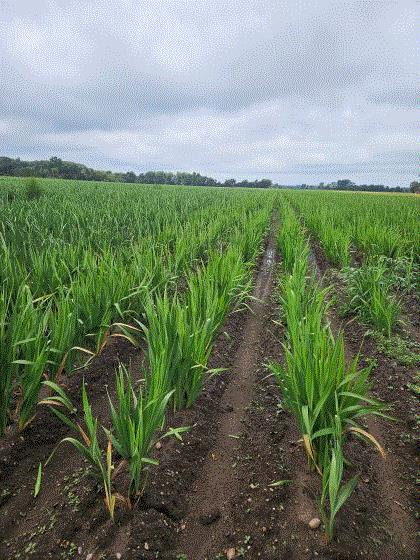
Glads as far as the eye can see at Great Lakes Glads.
Recently, I had the pleasure of touring
Great Lakes Glads in Bronson, Michigan.
This hidden gem is tucked away in rural southwest Michigan. Great Lakes Glads is the largest gladiolus farm in the United States. Bob Mayer, owner and operator, is a fifth-generation farmer, and alongside his sister, runs this incredible facility.
This farm is chockfull of history. During the Great Depression, they shipped their gladiolus via railroad car to Chicago and Detroit. Today, they produce 370 acres of gladiolus, 75 acres of sunflowers and 35 acres of peonies. They grow over 100 different varieties of gladiolus, some of which they even bred themselves! Great Lakes Glads ship their flowers to grocery stores across the nation.

Great Lakes Glads is one of the only farms left in the U.S. producing large volumes of glads. According to Bob, there were 13 gladiolus farmers in southwest Michigan in the 1970s. Now there only six growers nationally. This is due to legislation, labor challenges and disease. Michigan is a prime location for commercial production, since gladiolus rust cannot survive a Michigan winter. Deer, on the other hand, are a perennial challenge. They love to eat glads. Bob has come up with creative deterrents over the years, his electric fences (powered by marine batteries) only keep a fraction of the deer at bay. His beloved glads still get snacked on season after season. For those of you that have good luck with heavy deer pressure, and farm acreage drop me a line. I’ll forward your suggestions.
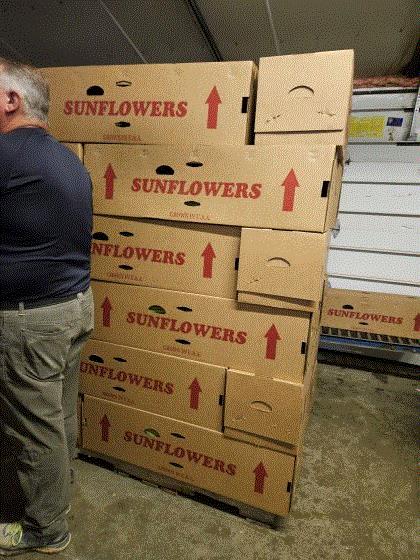 They sell a crazy amount of sunflowers, too!
They sell a crazy amount of sunflowers, too!
Bob’s peony fields were a sight to behold. Some of Bob’s favorite peony varieties are ‘Karl Rosenfield’, ‘Sarah Bernhardt’ and ‘Monsieur Jules Elie’.
Peony season dovetails into the start of gladiolus season. Some seasons they plant their glads as early as April to try to get an early crop. In the past they covered their early season plantings with black plastic in hopes of protecting them from frost. This isn’t just a few rows, this is acres worth of early season glads! It was hard for him to pick favorites, but two of Bob’s favorite gladiolus varieties are ‘Georgia Peach’ and ‘White Prosperity’. Some of the gladiolus varieties on his farm he remembers hand-pollinating the crosses to make them! It was incredible to listen to Bob’s passion and enthusiasm for each of them. Like many growers, these flowers are a lifelong passion and endless pursuit of perfection. Great Lakes Glads has strong relationships with bulb growers in the Netherlands to ensure premiere quality bulbs are available of their cherished varieties each season.
It was truly inspiring to connect with Bob and see his efficient crew at work. For instance, cut glads are incredibly heavy. It’s one of the crop’s unique qualities that limits its import; the freight would be astronomical. Lift a case of glads once, and you will understand the physical work it takes to cut, pack and ship these beauties.
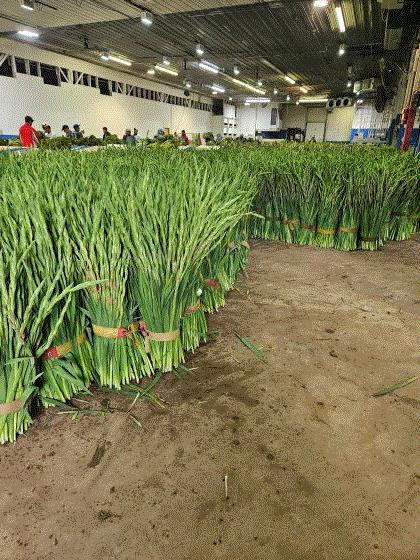 Hundreds of thousands of glads staged in the pole barn for packing and shipping
Hundreds of thousands of glads staged in the pole barn for packing and shipping
I learned a ton about gladiolus production from my visit. For instance, there are early-, mid-, and late-season varieties. Some glads finish in 65 days and others require 120. Strategic planning and planting allows for staggered harvest. Glads do not like nitrogen, so be sure to avoid overfeeding.
His crew cut over 300,000 gladiolus stems the day before the tour. On average they harvest over 33 million per year! Each gladiolus is hand cut before the first bud opens. This ensures that the flowers wont be damaged in transport and will give the consumer maximum vase life.
I asked Bob what three things he would tell new flower farmers. Here is what he said:
- Find your niche, and make sure you work hard to keep it.
-You work every day that ends in ‘y’, it’s a 24 hours a day, 365 days a year. If you don’t love it, the business won’t last.
-Be sure to know your walking-away point—price-wise—with clients, If you aren’t able to make a profit it’s not worth compromising your business, your principles or your crop. Stick to your guns.
Next time I shop at Meijer, I will be sure to pick up some of of Bob’s gladiolus. They are impeccable!
For more information on gladiolus production be sure to check out this
LINK from Kansas State University.


Enthusiastically!
Lindsay Daschner (and Tater)
Editor-at-Large—Bloom Beat
Owner—Forget-Me-Not Farms
This email was received by 6,313 of your fellow fresh-cut flower growers!
If you're interested in advertising in Bloom Beat, contact Kim Brown and she will hook you up!